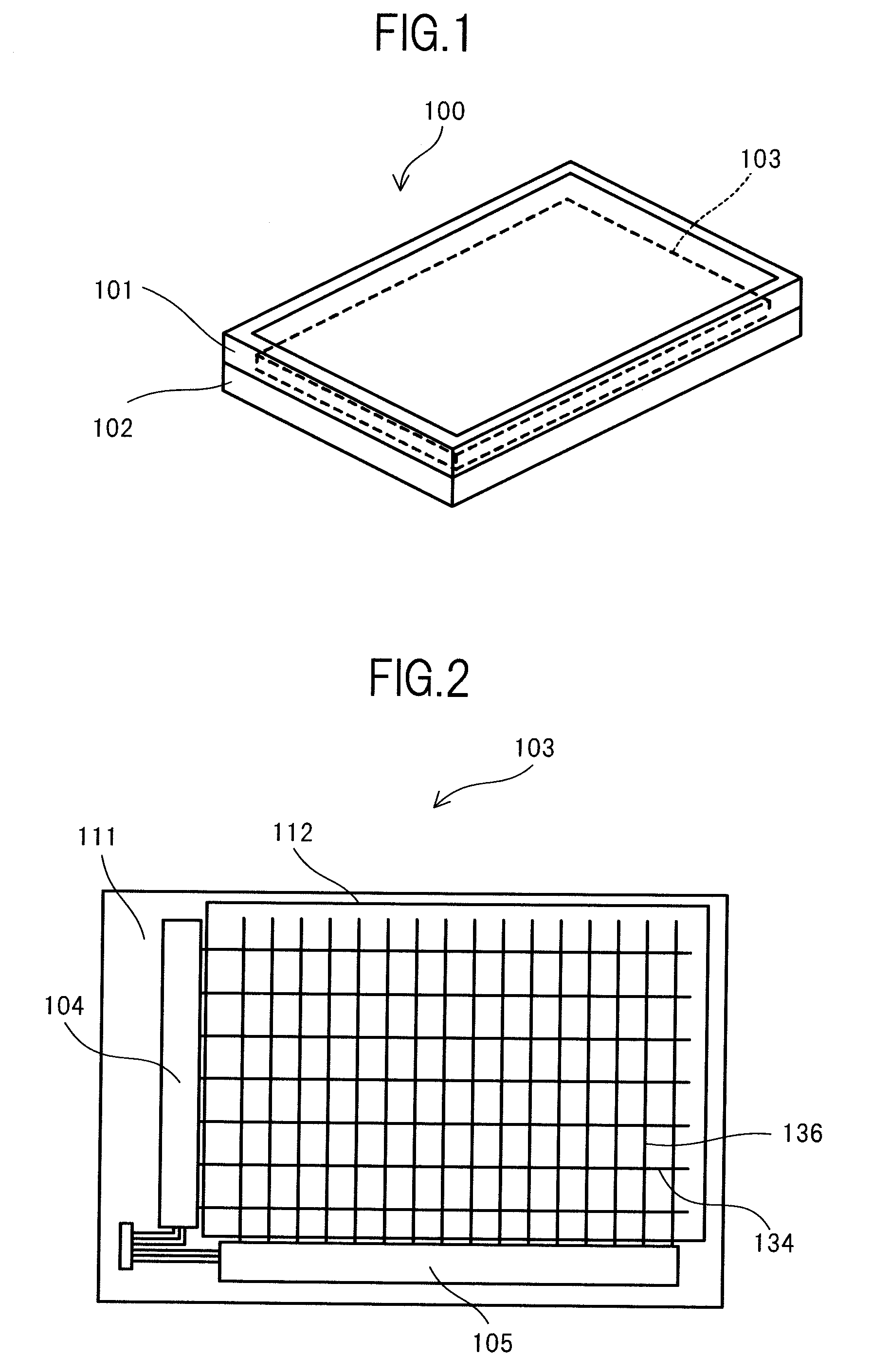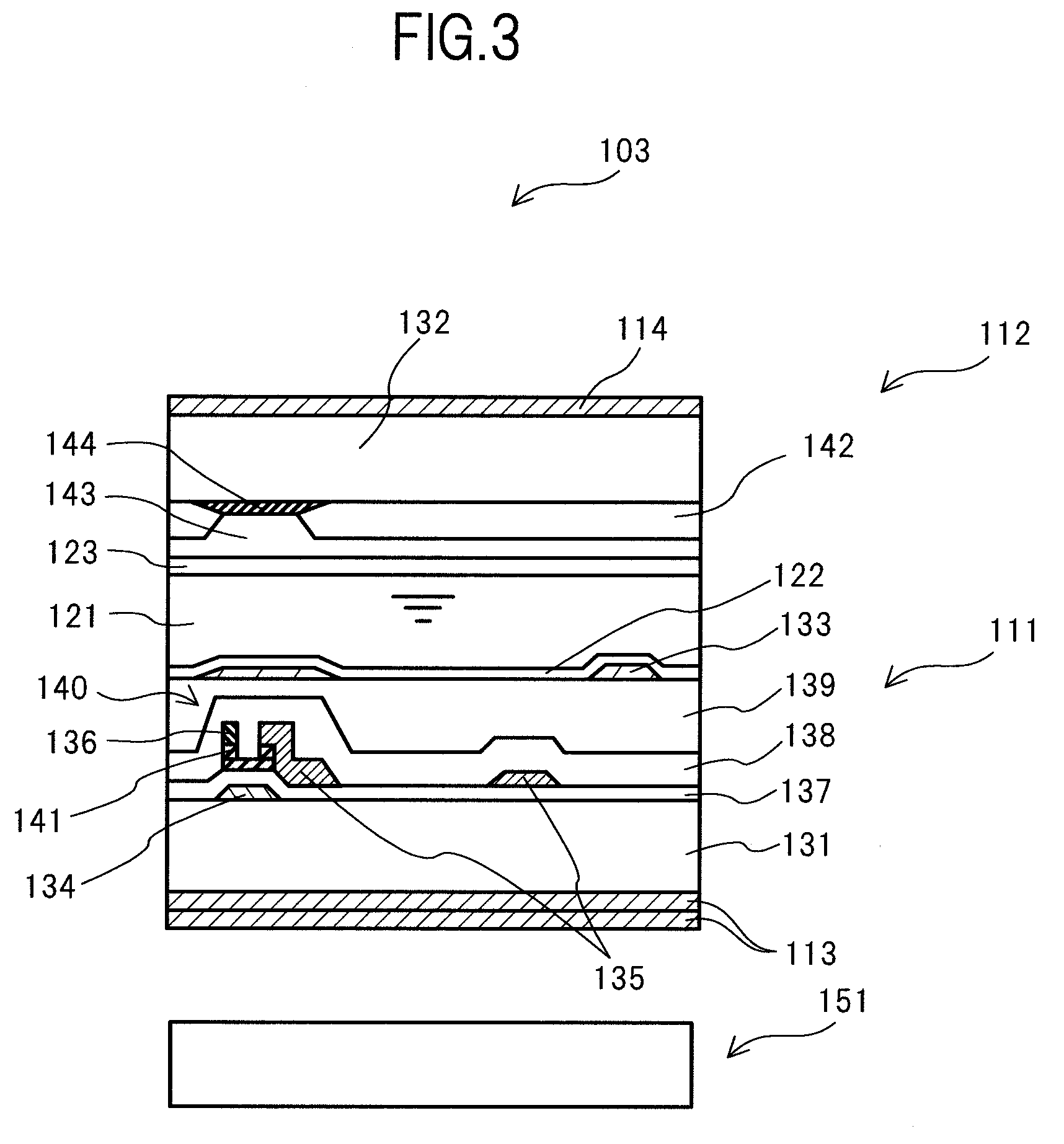Liquid crystal display device
a liquid crystal display and display device technology, applied in optics, instruments, optical elements, etc., can solve problems such as increasing power consumption, achieve the effects of enhancing the intensity of blue transmitted light, reducing power consumption, and increasing the effective display area
- Summary
- Abstract
- Description
- Claims
- Application Information
AI Technical Summary
Benefits of technology
Problems solved by technology
Method used
Image
Examples
embodiment 1
[0072]FIG. 1 schematically illustrates a liquid crystal display device 100 according to an embodiment mode of the present invention. As illustrated in FIG. 1, the liquid crystal display device 100 includes a liquid crystal display panel 103, which is fixed to be sandwiched between an upper frame 101 and a lower frame 102, a backlight unit (not shown), and other components.
[0073]FIG. 2 illustrates the structure of the liquid crystal display panel 103. The liquid crystal display panel 103 includes two substrates, an active matrix substrate 111 and a color filter substrate 112, between which a liquid crystal 121 is sealed. Scanning electrodes 134, which are controlled by a driver circuit 104, and signal electrodes 136, which are controlled by a driver circuit 105, run all over the active matrix substrate 111. These signal lines intersect each other to form pixels of the liquid crystal display device 100. The liquid crystal display panel 103 includes a number of pixels that corresponds ...
embodiment 2
[0105]FIG. 8 is a schematic sectional view of one pixel and its vicinities in the display panel 203 of the liquid crystal display device 200 according to the present invention. The exterior structure of the liquid crystal display device 200 and the display panel 203 is the same as the one described in Embodiment 1 with reference to FIGS. 1 and 2, and hence the description is not repeated here.
[0106](Active Matrix Substrate)
[0107]FIG. 9 is a schematic diagram of one pixel and its vicinities on an active matrix substrate 211 of the display panel 203 according to the present invention. FIG. 10 is an enlarged sectional view of a thin-film transistor and its vicinities on the active matrix substrate.
[0108]As illustrated in FIG. 10, a common electrode 233 made of indium-tin-oxide (ITO), a scanning electrode 234 made of molybdenum / aluminum (Mo / Al), and a common electrode wiring line (common wiring line) 246 are formed on a glass substrate 231 of the active matrix substrate 211. The common ...
embodiment 3
[0129]FIG. 14 is a schematic sectional view of one pixel and its vicinities in a display panel 303 of a liquid crystal display device 300 according to the present invention. The exterior structure of the liquid crystal display device 300 and the display panel 303 is the same as the one described in Embodiment 1 with reference to FIGS. 1 and 2, and hence the description is not repeated here. In Embodiment 3, components identical or similar to those in Embodiment 2 are denoted by the same reference symbols in order to omit their descriptions.
[0130](Color Filter Substrate)
[0131]In a color filter substrate 342 of Embodiment 3, a blue filter, a green filter, and a red filter have an area ratio of 1.09:1:0.85.
[0132](Color Filter Substrate-Side Alignment Film)
[0133]A color filter substrate-side alignment film 323 is formed as follows. As monomer components, diamine is prepared by mixing 4,4′-diaminoazobenzene and 4,4′-diaminobenzophenone at a molar ratio of 6:4, and an acid anhydride is pr...
PUM
 Login to View More
Login to View More Abstract
Description
Claims
Application Information
 Login to View More
Login to View More - R&D
- Intellectual Property
- Life Sciences
- Materials
- Tech Scout
- Unparalleled Data Quality
- Higher Quality Content
- 60% Fewer Hallucinations
Browse by: Latest US Patents, China's latest patents, Technical Efficacy Thesaurus, Application Domain, Technology Topic, Popular Technical Reports.
© 2025 PatSnap. All rights reserved.Legal|Privacy policy|Modern Slavery Act Transparency Statement|Sitemap|About US| Contact US: help@patsnap.com



